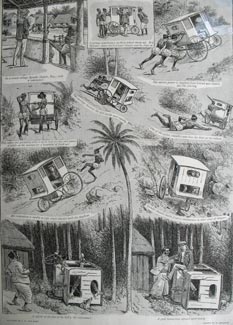When I bought a brand new 4-stroke three-wheeler for household use recently, I became curious about the origins in Sri Lanka of this extraordinarily versatile vehicle.
The fact that it is known in India as an auto-rickshaw is an obvious clue to its descent in design and convenience from the hand-pulled rickshaws of the late 19th century.
These were themselves a version of the palanquin in which a dignitary was carried by four men holding a pole at each corner of a litter. The addition of wheels was derived from the horse-drawn vehicles used by prosperous citizens and successful businessmen in the 19th century.
Two-rickshaws,-early-190.jpg) |
| Two rickshaws, early 1900s |
-Jinrickshaw,-early-1900.jpg) |
| Jinrickshaw |
The stately brougham sometimes seen in Colombo then was a one-horse closed carriage named after Lord Brougham who died in 1868. More common was the lowlier dogcart, a two-wheeled cart with cross-seats back to back. It originally contained a compartment for dogs, so its name was not entirely derogatory.
The gharry, a horse-drawn carriage introduced from India to ply the streets of Colombo for hire, served members of the public who could afford it. As many couldn’t, an alternative method of transport for hire was introduced in 1883. This was when the first rickshaws were imported to Ceylon by Messrs Whittall and Company.
Like the palanquin, these were man-powered not horse-drawn. The early models were driven by two “coolies” as they were known, one pulling and the other pushing from behind. These two-wheeled contraptions originally had iron wheels, which made them very difficult to manoeuvre and were noisy on Colombo’s streets.
They were small, lightweight carts with springs and large wheels. The rickshaw puller clutched the two shafts protruding from the front of the rickshaw and ran between them. The rickshaw actually began life in China and was transported from Shanghai to operate in Singapore in 1880. It became known at first as a Jinricksha, and had space for two passengers. The Ceylon version only carried one passenger.
A later model had lower, pneumatic wheels. Although this was an improvement, rickshaw pullers didn’t like it because its smaller wheels made it difficult to draw. It was only when the iron wheels were replaced with larger wheels fitted with solid tyres that the rickshaw became a popular mode of transport.
While the advent of the motorcar replaced rickshaws for private use, rickshaws remained available for the public to hire even after the introduction of trams in Colombo in the early 1900s. As recently as 1980, there were still some man-powered rickshaws plying for hire in Galle Fort.
Rickshaws were popular with early 20th century visitors for sightseeing. On the back of a postcard of a woman travelling in a jinrickshaw in Colombo, the writer has noted: “This is the mode of conveyance here. One can be hired for an hour for 25 cents (four pennies) and he’ll run you about all the time without stopping.”
The rickshaw gave its name to the auto-rickshaw or three wheeler in use in Sri Lanka today. The new model 4-stroke auto-rickshaw with three wheels has actually descended from the popular two-wheel Italian-made scooter, the Vespa.
The inventor of the Vespa, the Italian aircraft designer Corradino D’Ascaino, created a light, commercial three-wheel vehicle in 1948, called the TriVespa. In 1956 a cab was added to the design and the three-wheeler became known as the Piaggio Ape. Ape means bee in Italian, so perhaps it was called that because of the buzzing sound of the vehicle’s engine.
Long before that, in 1926, Jamnalal Bajaj, an adopted son of Mahatma Gandhi, founded the Bajaj Auto Company in India. Based on the Italian model, his company began manufacturing the three-wheel auto-rickshaw in India in 1959. It became a rear-engine vehicle in 1977.
 |
| The first three-wheeler, 1893 |
Following its importation to Sri Lanka in quantity in the 1980s the auto-rickshaw three-wheeler began to replace the Morris Minor as the taxi of Colombo and the country towns.
It had taken 90 years after the first Ceylonese three-wheeler took to the roads for a motorised version to be introduced. The Graphic, an illustrated journal published in England, in its issue of 11 November 1893, published illustrations of “A Ride In A Ceylonese Tricycle.” This is based on sketches supplied by the Ceylonese artist, J.L.K. Van Dort.
In what is irrefutable evidence about the existence of three wheelers in Ceylon long before a motorised one was invented in Italy, a sorry tale is unfolded.
The captions begin: “In a remote village, Spindle Shanks, Esq., seeks a conveyance.” It continues: “A curious contrivance on three wheels turns up. It is Hobson’s choice with friend Shanks, and he steps in.”
“The motive power,” the caption reads, “is supplied from behind and Shanks does the steering. Two coolies toil painfully with it up a steep ascent, and pause a while on the summit for a mouthful of fresh air.
“The carriage descends the hill easily and rapidly. One of the coolies stumbles and loses his hold on the vehicle. His companion is unable to cope single handed with the machine.”
It concludes: “Spindle Shanks makes frantic endeavours to steer clear of dangers. A capsize at the foot of the hill is the consequence. A good Samaritan appears opportunely.”
Fortunately, three-wheeler travel isn’t so hazardous now. |

Two-rickshaws,-early-190.jpg)
-Jinrickshaw,-early-1900.jpg)

